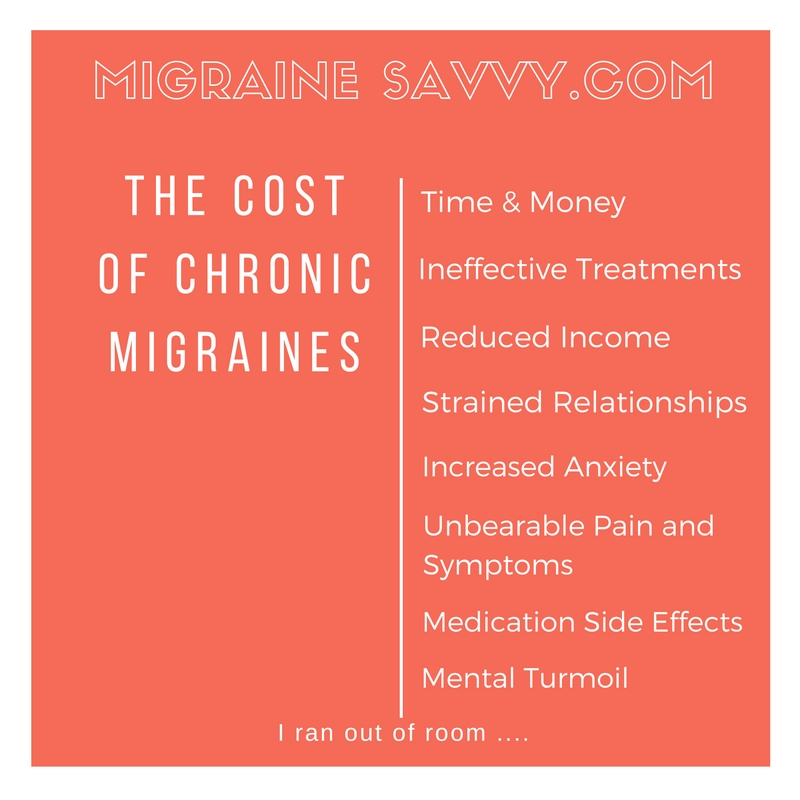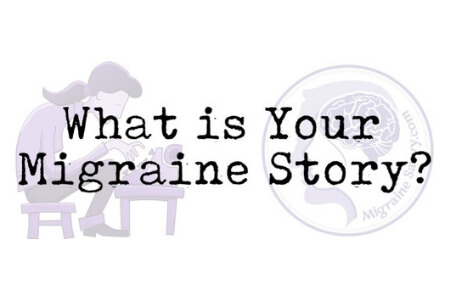- Home
- Your Stories
- The Cost of Migraines
COMPLETE MAGNESIUM SUPPORT
My Top Choice - Magnesium Breakthrough - The ONLY supplement with all 7 essential magnesium types in one formula. Most only have 1-2 types, leaving you deficient.
The Cost of Migraines: How To Save On Small Things
I'm not sure the true cost of migraines can be measured. By true cost I mean: mentally, emotionally, physically, spiritually, financially... what did I miss? Socially. For this article, I'll just talk about the cost in dollars.
The Migraine Research Foundation says that "Healthcare and lost productivity costs associated with migraine are estimated to be as high as $36 billion annually in the U.S."
That's just the United States statistics.
So far I have estimated that my own personal cost of migraines has been over $288,269.70 Australian dollars. I just spent $269.70 today on supplements. And that's just an estimate.
They will continue to cost me as long as I continue to have them. And it will increase should I continue to experiment with new alternatives. As I do!
That's almost the price of a house.
I just went to the doctor and it cost $210 for half an hour. I had 8 questions left over from the last appointment ($170) and after twenty minutes she said she felt overwhelmed and had to stop. That's not what I expected, but I still paid $210.
So, the fact is… that this illness can be overwhelming. If your condition becomes chronic, you may find yourself getting more emotional and confused as time goes on.
Health stuff sure gets me into my emotions and out of my logical calm, organized mind. Even after twenty years of going to doctors for migraines and CFS (chronic fatigue syndrome) some of the new areas, like genetics for example, sounds a little like they are speaking Klingon and can raise my anxiety levels.
Because new treatments and medications are coming along all the time, it is really important to keep good records of what you've tried and what has failed. You can save your own form on your computer or there are quite a few really good apps to keep track of your current symptoms and triggers, frequency, severity, and medications. Check out these ones - Use One of These Migraine Apps For Better Results.
Or here's a copy of my manual version...
Click here to download and print the PDF for the medication tracker I use.
Calculating The Cost of Migraines
Let me share some of my very own financial statistics with you in the hopes you won’t make the same mistakes as I did, long term.
Or at least give you some food for thought about how the cost of migraines can add up. Sadly and substantially.
They say you never forget your first migraine. I still remember mine.
I was throwing up at work within half an hour of eating a chocolate bar.
I've never eaten a Kit Kat again! Why did I go there... oh yes, lost wages!
Ok - so here are my figures roughly:
2016 – 1992 = 24 years of migraine
20 days each month x 12 = 240 days of migraine each year 24 years = 5,760 migraine days
$1,000 per month as per my records (was an accountant after all) – $12,000 per year x 24 = $288,000
Plus today's supplements:
Cost $288,269.70 to date
And that's not calculating lost income over the past sixteen years! I can't guess at that. Plus, it's just too depressing.
How To Get Some Free Migraine Help
To help you with keeping the cost of migraines down, here are 3 ways I can support you right now:
- come check out my Migraine Pain Management Course. The first module is free.
And, there's my free workshop. Here's the link:
My #1 Choice in Magnesium Supplements
This Is A Global Epidemic... You Are Not Alone
A billion people suffer with migraines, and only half get effective treatment. So, are you in the half a billion people putting up with migraine pain and long disruptive migraine episodes?
Are you suffering in silence or putting up with the pain because it's just what you are used to?
Or maybe your attacks are really mild and you don't need treatment. My migraines... destroy everything in their path. The cost for me, on every level, has been very high.
The Migraine World Summit presented some interesting facts, some of which I find truly shocking. And they might explain why the cost of migraines is so high:
- Migraines are more common than diabetes, epilepsy, and asthma combined. (1)
- One in seven people suffer from migraines … that’s one billion globally. (2)
- Less than half those with migraine consult a physician for it. (3)
- For those who do seek help, finding the right doctor can be difficult. Just 4 hours are committed to headaches disorders in undergraduate medical training worldwide. (4)
- The US is one of the few places where there are sub-specialty certifications for headache medicine, yet there is only 1 headache specialist for every 85,000 patients. (5) This shortage is consistent in most countries.
- The estimated annual cost of migraine in the US alone is over $17 billion. (6)
You need to be informed to make good treatment choices. Or it will cost you, in many unseen ways.
How To Save One Hundred Thousand Dollars
I think about where I can save money all the time. I cut the cleanser, shampoo, conditioner, sunscreen, makeup and hand cream bottles in half (anything plastic really) to get the remaining cream out.
There can sometimes be more than ten applications left inside the bottle. It's not just that, I try to recycle everything to help out our planet.
Check this out. I can't remember what book I read or what I was watching but I just wanted to go and test out what they were saying:
- What Saving Ten Dollars A Day Looks Like In Twenty Years - $100,827.16 at 3% Interest
- What Saving Twenty Dollars A Day Looks Like In Twenty Years - $201,654.33 at 3% Interest
You can print these out, so please let this inspire you to rethink some of your daily (wasteful) habits and to start saving money. I know you might not have $10 a day to save, but even just saving a little each week adds up.
AND it starts the energy flowing into "paying yourself first" and into your bank account. Energy flowing in, and mentally shifting to flowing in, is all good to combat the accumulating cost of migraines.
Other Ways to Save On Scripts and Supplements
I just checked with three different compounding pharmacies for my chelated magnesium and there was an $80 difference! It pays to do some research first, and then you can keep checking as you go. It does cost time, but I'd rather that than money!
The cost of magnesium glycinate varied by $80 between compounding chemists.
Ask your pharmacist which migraine medications are covered by Medicare (PBS here) or which ones are cheaper. Most have a generic version now. S/he will probably know more than your doctor. Try them first!
I have one client that cuts her Naramig in half and it works for her. The Maxalt she was on was $28 per tablet. And she was getting too much breakthrough pain, so bravely she tried another triptan.
The Naramig is under PBS - $6.10 for 4 tablets (currently here in Australia).
When I get put on a new supplement at the doctor's office, I always come home and check iHerb first and then Amazon. Some things are as much as half price. If the supplement is not there, I contact the manufacturer or look for a stockist online.
It always works out to be cheaper. And once you source it, you've got it. Remembering this is a lifelong condition :-( and the expenses will go on.
It can also pay to doctor shop! Instead of seeing a naturopath who charges $120 per hour, try to find a doctor who also uses a natural approach. Or there are many functional medical doctors now, so part of their charge will be covered by Medicare, or your insurance depending on what country you live in.
Or another area to help reduce the cost of migraines is to find a doctor who also does acupuncture. I used to pay $80 for one treatment, and now I pay $40 and some of it is rebated on Medicare. This is a significant difference when you are needing regular acupuncture to help combat attacks.
I've written more on that in this post - How Not To Get Rid Of Headache.
In other areas: some people I know water down their soap and shampoo to help lower their cost of migraines. I personally don't like to do that. But the soap works just as effectively.
Other little things like, using black printer ink that is recycled. I put it on saver mode and take off the color ink. I cook lots of stews and casseroles to make food last longer. Little things add up.
In summary, here are the key points:
Let's Recap...
- Check around for better prices on meds & supplements.
- Use treatments with good evidence behind them.
- Reduce your expenses where possible.
- Take care of your mental health.
- Be organized and plan ahead.
Just because there is no cure, doesn't mean you can't be healthy, happy and rich!
WANT MORE TIPS? Subscribe to my newsletter and follow along on Facebook and Pinterest for all of the latest updates.
MIGRAINE STORIES Related Articles
How to be more MIGRAINE SAVVY right now...
Cost of Migraines Resources:
1. The Migraine Research Foundation - Migraine Facts. Was [online] at: https://migraineresearchfoundation.org/about-migraine/migraine-facts/ Accessed online 05/05/16.
2. The MigraineWorldSummit.com - about. Accessed online 05/05/16.
Literature Cited at Migraine World Summit:
1) Steiner TJ et al. The prevalence and disability burden of adult migraine in England and their relationships to age, gender and ethnicity. Cephalalgia. 2003;23(7):519-527.
2) Steiner TJ et al. Migraine: the seventh disabler. The Journal of Headache and Pain 2013, 14:1.
3) Pavone E et al. Patterns of triptans use: a study based on the records of a community pharmaceutical department. Cephalalgia. 2007;27(9):1000-4.
4) World Health Organization. Atlas of headache disorders and resources in the world 2011.
5) Mauser, Emily D., and Noah L. Rosen. “So many migraines, so few subspecialists: Analysis of the geographic location of United Council for Neurologic Subspecialties (UCNS) certified headache subspecialists compared to United States headache demographics.” Headache: The Journal of Head and Face Pain 54.8 (2014): 1347-1357.
6) Goldberg, Lawrence D. “The cost of migraine and its treatment.” The American journal of managed care 11.2 Suppl (2005): S62-67.


















